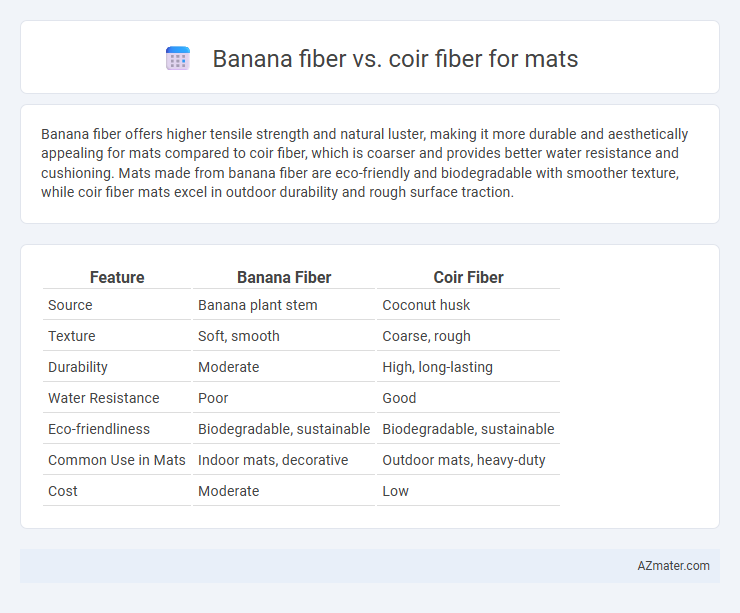Banana fiber offers higher tensile strength and natural luster, making it more durable and aesthetically appealing for mats compared to coir fiber, which is coarser and provides better water resistance and cushioning. Mats made from banana fiber are eco-friendly and biodegradable with smoother texture, while coir fiber mats excel in outdoor durability and rough surface traction.
Table of Comparison
| Feature | Banana Fiber | Coir Fiber |
|---|---|---|
| Source | Banana plant stem | Coconut husk |
| Texture | Soft, smooth | Coarse, rough |
| Durability | Moderate | High, long-lasting |
| Water Resistance | Poor | Good |
| Eco-friendliness | Biodegradable, sustainable | Biodegradable, sustainable |
| Common Use in Mats | Indoor mats, decorative | Outdoor mats, heavy-duty |
| Cost | Moderate | Low |
Introduction to Natural Fibers for Mats
Natural fibers for mats include banana fiber and coir fiber, both valued for their sustainability and durability. Banana fiber, extracted from the pseudostem of banana plants, offers a smooth texture and high tensile strength, making it ideal for lightweight, eco-friendly mats. Coir fiber, derived from coconut husks, provides excellent water resistance and robust coarse fibers suitable for heavy-duty mats with superior durability and traction.
Overview of Banana Fiber
Banana fiber, extracted from the pseudostem of banana plants, is a natural textile fiber known for its durability, flexibility, and eco-friendliness compared to coir fiber from coconut husks. It possesses high tensile strength and a smooth texture, making it ideal for mats that require both softness and resilience. The biodegradable nature and sustainable production process of banana fiber contribute to its growing popularity in environmentally conscious mat manufacturing.
Overview of Coir Fiber
Coir fiber, derived from the outer husk of coconuts, is a durable and coarse natural fiber commonly used in mat production due to its resilience and water resistance. It offers superior strength and abrasion resistance compared to banana fiber, making it ideal for outdoor and heavy-duty mats. Coir fiber's natural bristle-like texture enhances grip and durability, contributing to long-lasting, eco-friendly mat solutions.
Extraction and Processing Methods
Banana fiber extraction involves a manual or mechanical process called retting, where the outer pseudostem is soaked to separate the fibers, followed by scraping and drying to obtain fine, soft fibers suitable for mats. Coir fiber is extracted from the husk of coconut shells through retting or mechanical decortication, resulting in coarse and stiff fibers that require washing and combing to remove impurities before mat production. The longer retting duration for banana fiber yields a smoother texture, while coir's more robust processing supports durability in mat applications.
Physical and Mechanical Properties Comparison
Banana fiber exhibits higher tensile strength and flexibility compared to coir fiber, making it more suitable for mats requiring durability and resistance to wear. Coir fiber, derived from coconut husk, has greater coarseness and water resistance but lower elongation, resulting in sturdier but less flexible mats. The density of banana fiber is lower than coir, contributing to lighter-weight mats with better cushioning properties.
Environmental Impact and Sustainability
Banana fiber offers a more sustainable alternative to coir fiber in mat production due to its biodegradability and lower water and chemical usage during extraction. Coir fiber, derived from coconut husks, is durable but involves energy-intensive processing and significant waste generation. Choosing banana fiber mats reduces environmental impact by utilizing agricultural waste and promoting eco-friendly disposal.
Durability and Maintenance in Mat Applications
Banana fiber offers higher durability in mat applications due to its tensile strength and resistance to wear compared to coir fiber, which tends to be coarser and less flexible. Maintenance of banana fiber mats requires less frequent replacement and is easier due to their smoother texture that resists dirt accumulation, while coir mats demand regular cleaning and can degrade faster in moist conditions. Choosing banana fiber improves longevity and reduces upkeep costs in high-traffic mat environments.
Cost-effectiveness and Market Availability
Banana fiber offers higher cost-effectiveness than coir fiber due to its lower raw material price and quicker processing time, making it ideal for budget-conscious mat production. Coir fiber is more widely available in global markets, especially in regions like India and Sri Lanka, ensuring consistent supply but often at a higher price point. Manufacturers prefer banana fiber for eco-friendly, economical mats, while coir remains popular for its durability and established market presence.
Aesthetic and Design Possibilities
Banana fiber offers a finer texture and lighter color, enabling intricate weaving patterns and vibrant dye absorption that enhance aesthetic appeal in mats. Coir fiber is coarser and darker, providing a rustic, natural look with high durability but limited flexibility for detailed designs. Designers favor banana fiber for elegant, lightweight mats with complex motifs while coir is preferred for robust, traditional-style mats with earthy tones.
Choosing the Best Fiber for Mat Production
Banana fiber offers superior softness, flexibility, and moisture absorption, making it ideal for mats requiring comfort and durability. Coir fiber, derived from coconut husks, excels in strength, water resistance, and rough texture, suited for heavy-duty outdoor mats. Selecting the best fiber depends on mat usage: banana fiber for indoor, decorative mats and coir fiber for rugged, weather-resistant applications.

Infographic: Banana fiber vs Coir fiber for Mat
 azmater.com
azmater.com